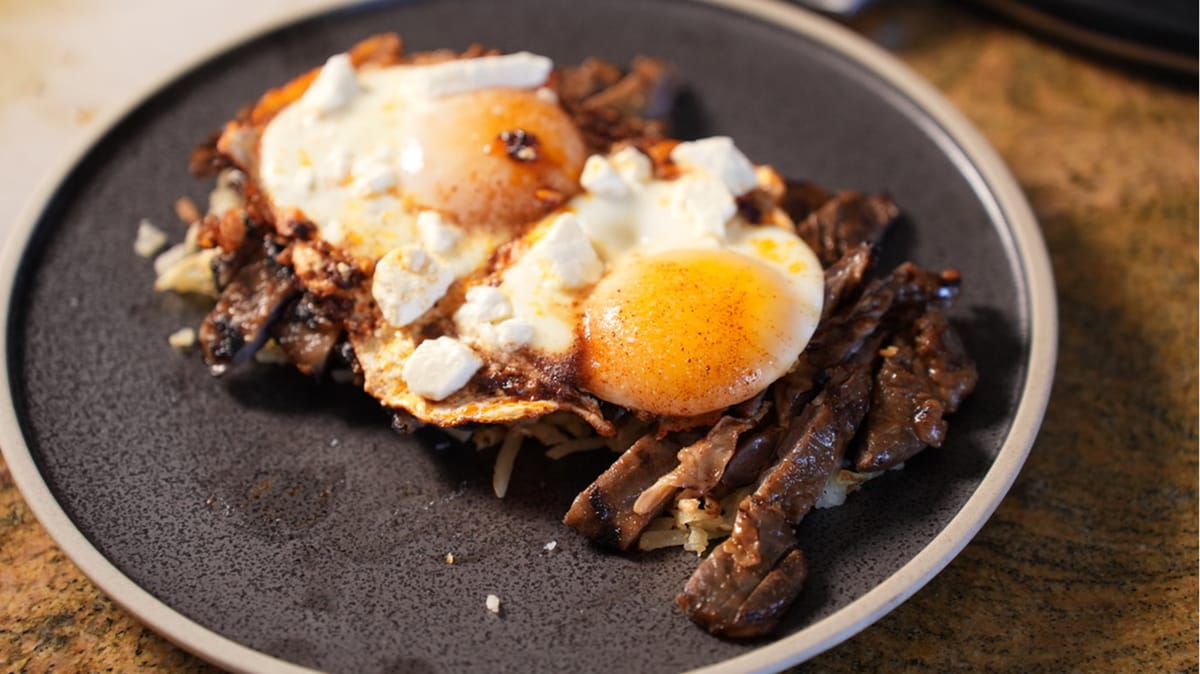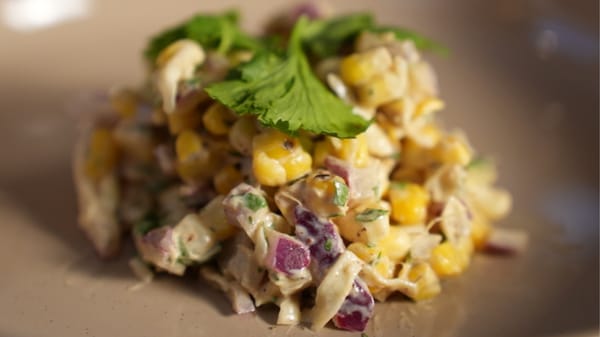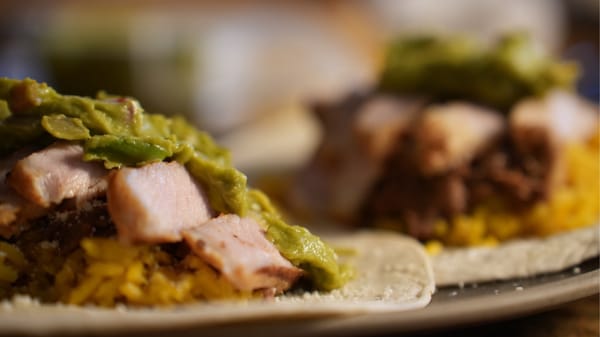Weekly R&R #005: Gochujang-Glazed Steak and Chili Crisp Eggs on Diner Hash

The Recipe
Ingredients
For the Steak
- 8–10 oz skirt steak or flank steak
- Kosher salt & black pepper (for dry brine)
- 1 tbsp neutral oil for searing
Gochujang Marinade:
- 1 tbsp gochujang
- 2 tsp soy sauce
- 1 tsp rice vinegar or lime juice
- 1 tsp honey or brown sugar
- 1 tsp sesame oil
- 1 clove garlic, grated
- 1–2 tbsp water (to thin if needed)
For the Diner Hash (Idaho Spuds Version)
- 1 carton Costco Idaho Spuds Hash Browns
- Boiling water
- 1–2 tbsp neutral oil (canola, avocado, etc.)
- Kosher salt & black pepper
- Optional: smoked paprika, garlic powder, onion powder
For the Chili Crisp Eggs
- 2 eggs
- 1–2 tsp chili crisp (oil + solids)
- Optional: crumbled feta (2–3 tbsp)
Optional Garnishes
- Sliced scallions
- Sesame seeds
- Pickled onions or radish
- Lime wedge
- Chili crisp drizzle
Prep Instructions
2 Days Before (Optional Dry Brine)
- Pat steak dry.
- Lightly season both sides with kosher salt.
- Place on a wire rack set over a plate or tray and refrigerate uncovered overnight (12–24 hrs).
1 Day Before (Marinate)
- Wipe off excess surface moisture from steak.
- Mix marinade ingredients in a small bowl or Ziploc bag.
- Add steak and marinate in the fridge overnight (8–12 hrs).
Cooking Instructions
1. Hydrate the Hash Browns
- Open Idaho Spuds carton and fill with boiling water to the fill line.
- Close and let sit for 12 minutes. Drain or fluff if needed.
2. Make the Gochujang Glaze
- In a small bowl, mix: gochujang, soy sauce, vinegar, honey, sesame oil, garlic, and a splash of water to thin.
- Set aside.
3. Sear the Steak
- Remove steak from marinade and pat dry.
- Heat 1 tbsp oil in cast iron or heavy skillet over medium-high heat.
- Sear steak 1½–2 minutes per side for medium-rare.
- Let rest 5–10 minutes on a cutting board.
- Meanwhile, return pan to low heat, add the glaze, and stir until slightly thickened (~30 seconds).
- Slice steak against the grain and return to pan to coat in glaze.
4. Fry the Hash Browns
- Heat oil in cast iron skillet over medium-high heat.
- Add rehydrated hash browns, press into an even layer.
- Let brown undisturbed for 4–5 minutes.
- Season with salt, pepper, and optional smoked paprika or garlic powder.
- Flip, crisp the other side, and cook until golden and crispy.
5. Fry the Chili Crisp Eggs
- Heat chili crisp (oil + solids) in a nonstick skillet over medium heat.
- Crack in eggs and fry until edges are crispy and whites are set, about 3–4 minutes.
- Spoon hot oil over the whites as they cook.
- Add crumbled feta during the last 30 seconds or after plating, if using.
Assemble & Serve
- Spoon a bed of crispy hash onto each plate.
- Fan out sliced gochujang-glazed steak on top.
- Crown with chili crisp eggs.
- Garnish with scallions, sesame seeds, lime, or extra chili oil as desired.
The Reflection
This recipe, like most of my culinary ideas, started with a spark of inspiration. I was at a new tapas restaurant that served a gochujang-glazed crispy Brussels sprout dish as part of their menu. It wasn’t the first time I’d had gochujang, but it was the first time I’d seen it used in that way, and it immediately made me want to experiment. Within a week, this dish was starting to come together in my kitchen.
That’s sort of become my rhythm for creating recipes these days: take a spark from somewhere — a meal out, a post I saw online — and then let what’s already in my fridge or what deals are going on at the store that week shape the rest. In this case, flank steak happened to be on sale, and my mind immediately went to breakfast. I’d been curious about chili crisp eggs for a while, and it felt natural to bring those together with the steak. From there, I leaned on AI to help balance the marinade and think through timing. What I like about that process is how it feels less like following a script and more like frictionless co-creating.
I’ve realized one of the best parts of cooking, for me, is that it doesn’t have to start from scratch. It’s about noticing, borrowing, adapting, and making it your own. The more I cook this way, the more I’ve come to appreciate that constraints — what’s on hand, what’s affordable, what you’ve got time for — don’t limit creativity. They actually create the space for it.
And honestly, that’s one of the quiet joys I have found when partnering with AI in the kitchen. It gives us permission, as adults, to ask why or how again, without judgment. The same questions you ask when you’re first learning anything, before you’re supposed to already know the answers. It’s a way of rediscovering curiosity and letting yourself experiment, whether the dish turns out perfectly or not.
In the end, this recipe was just steak, eggs, and potatoes. But layered together, it became something more than just a brunch staple in my kitchen: a reminder that cooking is less about perfection and more about exploration.





